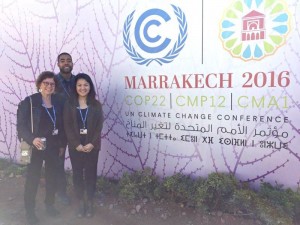The Director of the new Climate Technology Center and Network, Jukka Uosukainen from Finland, told the RINGO meeting earlier this week that “climate is almost everything.” In other words, it is about health, technology, development goals, forestry, agriculture, gender equity, status and fate of indigenous peoples, equity, North/South relations, and more. The Director’s point was that the UNFCCC Green Climate Fund could not be successful if it was open to everything. Money to meet COP goals is a big issue, whether it is for capacity building, technology transfer, loss & damage, adaptation, mitigation, monitoring, or for meeting the sustainable development goals.
Someone astutely observed to me while we were in Warsaw for COP19 that there are so many needs in developing countries, yet they all have to be expressed in terms of climate change. That is the currency of UNFCCC. This reminds me of something I assign in Con Law by A. Sarat (if you go to court, you fight on the terrain and use the language that is legally cognizable, e.g. rights rather than needs). Perhaps UNFCCC, which has 25,000 international participants in its two-week annual forum, despite its often excrutiatingly slow action, IS a fairly successful international forum for pressing a wide ranging agenda. A wide-ranging set of actors come here to press their cases. Yet despite lots of interesting ideas sparked here (a new network of research institutions seeking to revision and expand capacity building is just one), there are many competing requests and expectations about the flow of money to address climate change. Finance (for adaptation/mitigation) remains one of the most difficult issues at COP22 in its final hours.
Some of the progressive NGO voices here, and some of the poorer developing nations, point out that developed countries are reluctant to fund adaptation projects in a number of countries. Public monies from governments seek to leverage private investment. With regard to non-governmental funding, businesses want their activities to be profitable, the political environment to be stable. The ECO-NGO newsletter of Nov. 18th at COP22 says that the Parties’ own biennial reporting reveals that G7 nations plus Australia are providing $3.4 billion/year in public finance for adaptation activities in developing countries, but at the same time, these same countries have provided almost $67 billion/year in subsidies and public finances in support of oil, gas, and coal production (at home and abroad). This doesn’t sound terribly sustainable–or sustainability-conscious.
I am sitting in Friday’s high-level segment of the Climate Vulnerable Forum, where 47 nations in the CVF announced they will scale-up their climate commitments, develop long-range low emissions strategies, and use renewables to meet their energy needs. It is inspiring that the most vulnerable and relatively poor nations are helping lead the way, yet their commitment needs not only to be matched but surpassed by those nations that are more advantaged. And these nations need, at a minimum, to deliver the financing to which they have committed.









